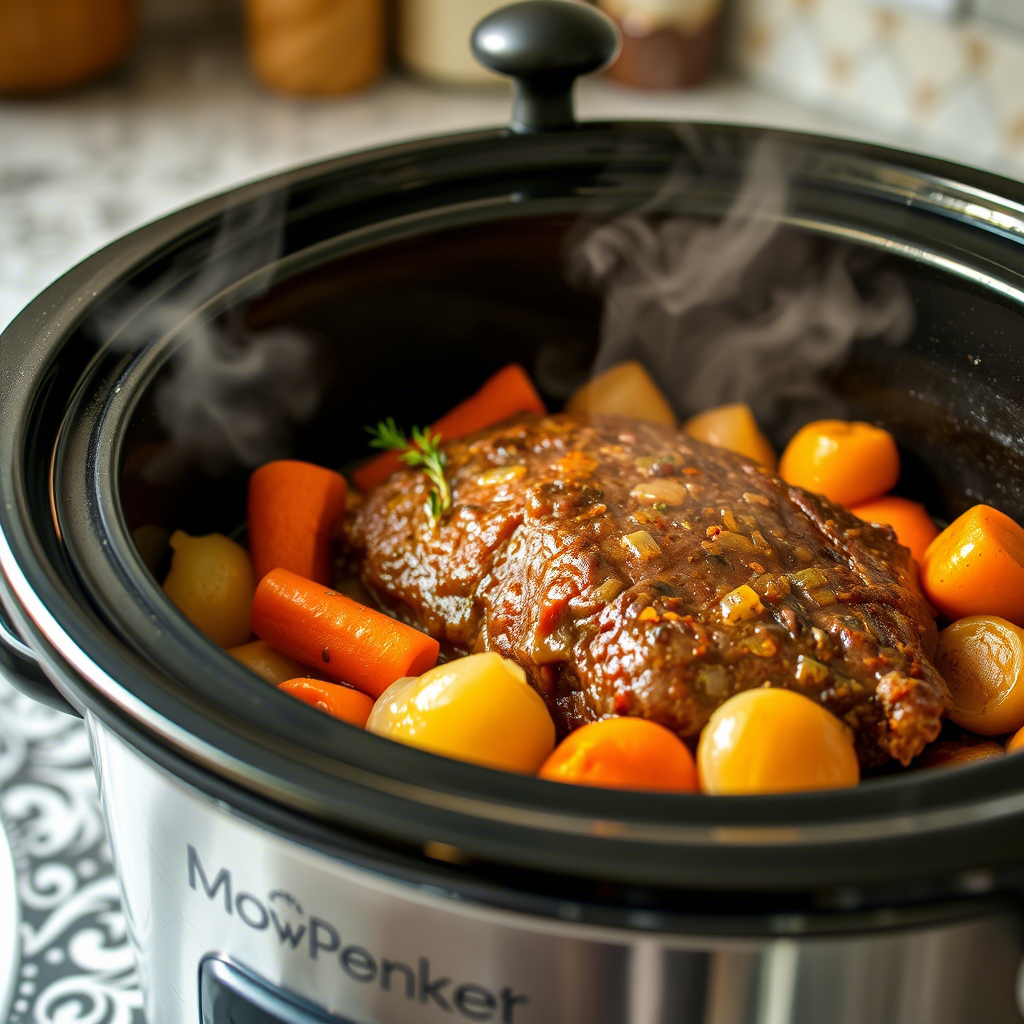Slow Cooker Beef Rump — Tender, Flavorful, Effortless

There are few things more satisfying than a beautifully cooked beef rump that’s fall-apart tender and packed with flavor. And for me, as someone who has worked in professional kitchens for years, the slow cooker is one of the most underappreciated tools when it comes to cooking tough cuts like beef rump.
Beef rump isn’t a delicate steak — it’s a hardworking muscle, which means it needs time and patience to transform into something special. That’s exactly where slow cooking shines.
Why Beef Rump is Perfect for the Slow Cooker
Tough Cut, Big Reward
Rump comes from the rear part of the cow — lots of movement, lots of connective tissue. If you try to quick-cook it like a sirloin, you’ll end up chewing for hours. But give it low heat and time? Magic happens.
Benefits of Slow Cooking Beef Rump
- Breaks down collagen for tenderness
- Rich, deep beef flavor develops slowly
- Very little hands-on work
- Forgiving cut — hard to mess up
- Great for meal prep or feeding a family
This is a working man’s roast. Simple, affordable, hearty.
Best Slow Cooking Methods for Beef Rump
Traditional Slow Cooker (Crock-Pot)
Temperature: Low
Time: 8-10 hours
This is my favorite method. Long and gentle — the meat relaxes into buttery softness without drying out.
Slow Cooker on High
Temperature: High
Time: 4-6 hours
Good option if you’re short on time, but be aware — low and slow always wins in flavor and texture.
Dutch Oven in the Oven
Temperature: 150°C / 300°F
Time: 3-4 hours
Basically slow cooking, but in your oven. Cover tightly and check occasionally.
Pressure Cooker (Alternative)
Time: 60-75 minutes under pressure
Fast, but lacks the deep flavor of a true slow cook.
Ingredients for Slow Cooker Beef Rump

| Ingredient | Amount | Notes |
|---|---|---|
| Beef Rump Roast | 1.5 to 2 kg (3 to 4 lbs) | Trimmed, but leave some fat for flavor |
| Onion, sliced | 1 large | Adds sweetness and body |
| Garlic, minced | 4 cloves | Fresh is best |
| Carrots, chopped | 3 medium | For sweetness and color |
| Celery, chopped | 2 stalks | Optional, but great for base flavor |
| Beef Broth | 2 cups | Homemade if possible |
| Worcestershire Sauce | 2 tbsp | Deepens the umami |
| Dijon Mustard | 1 tbsp | Optional, for a subtle bite |
| Thyme | 1 tsp | Fresh or dried |
| Bay Leaves | 2 | Removed before serving |
| Salt & Pepper | To taste | Season well |
| Olive Oil | 1 tbsp | For browning (optional) |
How to Cook Beef Rump in a Slow Cooker
Step 1 — Brown the Meat (Optional but Recommended)
Sear the rump roast in a hot pan with olive oil. It’s not required, but browning adds a deep, savory crust.
Step 2 — Layer Vegetables
Place onions, carrots, and celery at the bottom of the slow cooker. They’ll form a flavorful bed for the beef.
Step 3 — Add the Beef and Seasoning
Place the beef rump on top. Sprinkle with salt, pepper, thyme, and garlic. Add bay leaves.
Step 4 — Add Liquids
Pour in beef broth, Worcestershire sauce, and mustard.
Step 5 — Cook Low and Slow
- LOW for 8-10 hours
- HIGH for 4-6 hours
Step 6 — Rest and Slice
Remove the beef carefully — it’ll be incredibly tender. Let it rest 10-15 minutes before slicing against the grain.
Storage and Expiry
Fridge
- Store leftovers in an airtight container.
- Keeps well for 3-4 days.
- Always cool completely before storing.
Freezer
- Beef rump freezes beautifully.
- Portion into freezer bags or containers.
- Keeps for up to 3 months.
Reheating
- Gentle stovetop reheating is best, adding a splash of broth if needed.
- Microwave works for small portions but go low and slow.
Alternative Cooking Methods for Beef Rump
Oven Roasting
- 150°C / 300°F for 3-4 hours, covered.
- Add broth or wine to prevent drying.
Pressure Cooking
- 60-75 minutes under pressure.
- Quick release for slicing; natural release for shredding.
Stovetop Braising
- Heavy pot, low simmer, 3+ hours.
- Keep adding liquid to avoid burning.
Tips for Best Results (from the Chef)
Slow cooking a beef rump roast to perfection requires a few key techniques that I always follow as a professional chef:
- Sear the roast first: Browning the beef on all sides in a hot pan before slow cooking locks in juices and adds deep, savory flavor.
- Use a flavorful broth: Instead of water, use beef stock, bone broth, or even a splash of red wine to create a rich base for your roast.
- Layer your vegetables properly: Place hearty vegetables like carrots and potatoes at the bottom of the slow cooker. This ensures they cook evenly and absorb the juices.
- Don’t lift the lid too often: Every time you open the slow cooker, you lose valuable heat and extend cooking time. Trust the process.
- Check for tenderness, not just time: Cooking times may vary slightly depending on the size of the roast. Test with a fork – it should slide in easily.
- Let it rest: After cooking, allow the roast to rest for about 10 minutes before slicing. This keeps the meat juicy and flavorful.
- Optional finishing touch: If you prefer a thicker sauce, remove the roast and vegetables, then simmer the juices in a saucepan with a bit of cornstarch slurry.
Following these steps will ensure your slow-cooked beef rump roast turns out tender, aromatic, and absolutely unforgettable.
FAQ – Slow Cooker Beef Rump Roast
Should I sear the beef before putting it in the slow cooker?
Yes, searing the beef enhances the flavor and texture by creating a delicious caramelized crust.
What size roast works best for slow cooking?
A beef rump roast weighing between 1.5 to 2.5 kg (3 to 5 pounds) is ideal for even and tender results in a standard 6-quart slow cooker.
Can I cook the roast on high instead of low?
You can cook it on high for 4–5 hours, but slow cooking on low for 8–9 hours yields much more tender and flavorful results.
What vegetables go best with beef rump roast?
Classic choices include carrots, potatoes, onions, celery, and parsnips. They cook beautifully with the meat and soak up the rich juices.
How can I prevent my roast from becoming dry?
Make sure there is enough liquid (broth or stock) in the slow cooker, avoid overcooking, and always let the meat rest before slicing.
Can I add herbs and spices for extra flavor?
Absolutely! Rosemary, thyme, bay leaves, and garlic are classic additions that complement beef perfectly.
How do I know when the beef is done?
The beef is done when it’s fork-tender — meaning a fork easily slides into the meat with little resistance.
Should I slice or shred the cooked roast?
Both methods work! Slice for a traditional roast presentation, or shred for a more rustic, pulled-beef style dish.
How do I store and reheat leftovers?
Store leftovers in an airtight container in the refrigerator for up to 4 days. Reheat gently in a saucepan or microwave to maintain moisture.
Can I freeze cooked beef rump roast?
Yes, cooked beef rump roast freezes very well. Cool completely, then store in airtight freezer bags for up to 3 months.